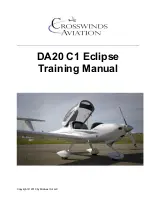
Pilots Operating Handbook
32/76
YL-MFG
Revision 7, Issue 1
4/6/2016
(1) CABIN
1. Pilot's Operating Handbook - AS DESIRED
2. MFD Pilot’s Guide - AS DESIRED
3. Pilot’s Checklist - ACCESSIBLE TO PILOT
4. Throttle Lever - CHECK (free movement)
5. Parking Brake - SET
6. GRS Activation Handle (if installed) - CHECK
a. Handle Mount - CHECK (security and condition)
b. Safety Pin - INSTALLED AND FLAG ATTACHED
c. Activation Cable - CHECK (security and condition)
7. MASTER Switch - ON
8. AVN MASTER Switch - ON
9. Primary Flight Display (PFD) - CHECK (verify PFD is ON and software current, no faults
displayed)
10. Wing Flaps - UP
11. Elevator Trim Control - T/O POSITION
12. Avionics Cooling Fan - CHECK (verify fan is operational)
13. Airplane Weight and Balance - CHECKED and ENTERED
14. Fuel Quantity Indicators - CHECK (L and R)
WARNING: Takeoff is prohibited with less than
¼
tank of fuel. When manually rotating
the propeller, treat the propeller as if the ignition switch was on. Do not stand, nor allow
anyone else to stand, within the arc of the propeller since a loose or broken wire, or a
component malfunction, could cause the engine to start.
15. IGNITION Switch - OFF
16. AVN MASTER Switch - OFF
17. MASTER Switch - OFF
(2) LEFT WING
1. Main Wheel Tire - CHECK (proper inflation 30 PSI and general condition (weather checks, tread
depth and wear, etc.)
2. Brake Line - CHECK (security and condition)
3. LDG GEAR and gear door - CHECK (security and condition)
4. Wing Tie down - DISCONNECT if installed (check security and condition)
5. Fuel Tank Vent - CHECK (for blockage)
6. Fuel Tank Sump Quick Drain Valves - DRAIN
Drain at least a cupful of fuel (using sampler cup) from each sump location to check for water,
sediment, and proper fuel grade before each flight and after each refueling. If water is observed,
take further samples until clear and then gently rock wings and lower tail to the ground to move any
additional contaminants to the sampling points. Take repeated samples from all fuel drain points
until all contamination has been removed. If contaminants are still present, refer to WARNING
below and do not fly airplane.
NOTE:
Collect all sampled fuel in a safe container. Dispose of the sampled fuel so that it does
not cause a nuisance, hazard, or damage to the environment
WARNING: If, after repeated sampling, evidence of contamination still exists, the
airplane should not be flown. Tanks should be drained and system purged by qualified
maintenance personnel. All evidence of contamination must be removed before further
flight.
7.
Fuel Quantity - CHECK VISUALLY (for desired level)






































